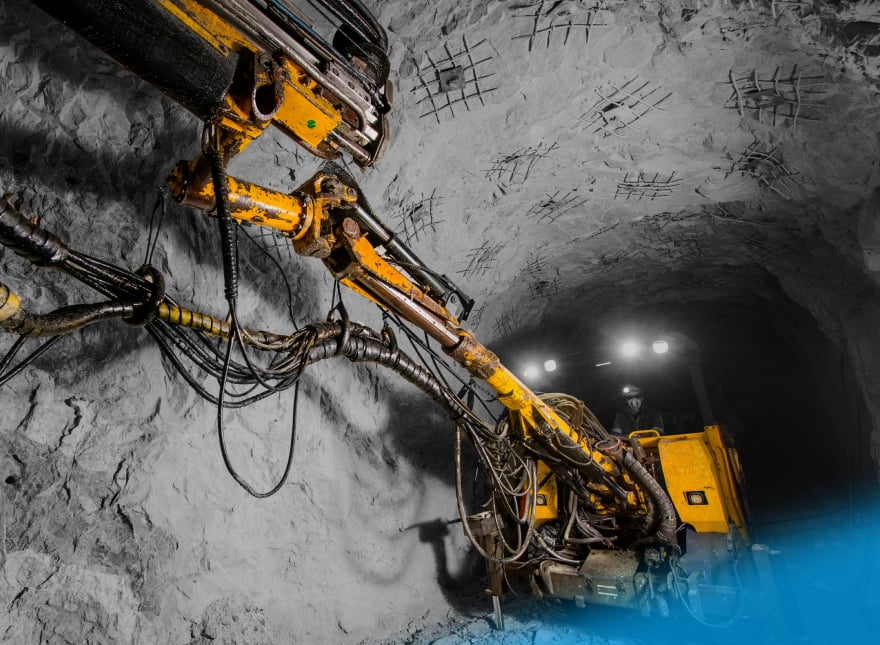Check out our latest blog article: From component to enterprise – modular robotics done right.
How Supply Chain Innovation Helps Businesses Survive Global Crisis
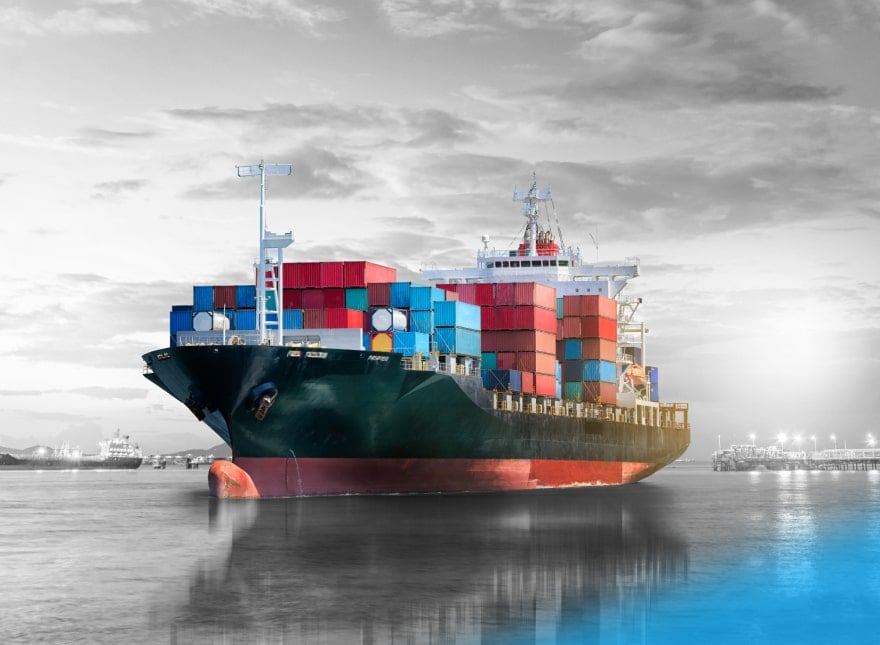
The farm-to-table supplier of chicken products, George’s, serves 250 fast-food restaurants. On one delivery day, each truck makes about 35 stops. Planning these routes manually was a mind-blowing task for George’s employees, so the company decided to use AI. As a result, they managed to reduce their fleet size by 10% and save $31k per year in fuel costs. This became especially important in the context of rising diesel prices.
Along with rising fuel costs, companies are having to cope with other supply chain problems. In this article, we’ll talk more about them and provide five supply chain innovation examples that will help businesses stay on track.
Investors Are Piling Into Supply Chain Technology
Many business owners now focus on supply chain innovation. The potential range of uses for technology in the supply chain is wide, as most companies still rely on pen, paper, and spreadsheets.
Venture capital activity in the area is also growing. Until a few years ago, investors had little interest in supply chain tech. Now, we are seeing an increase in investment activity and deal size. Here’s what the statistics show.
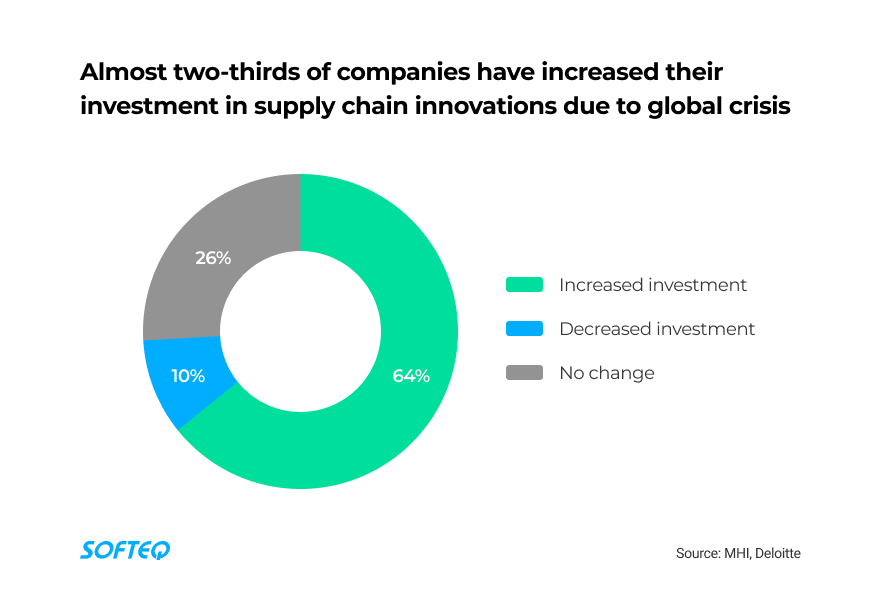
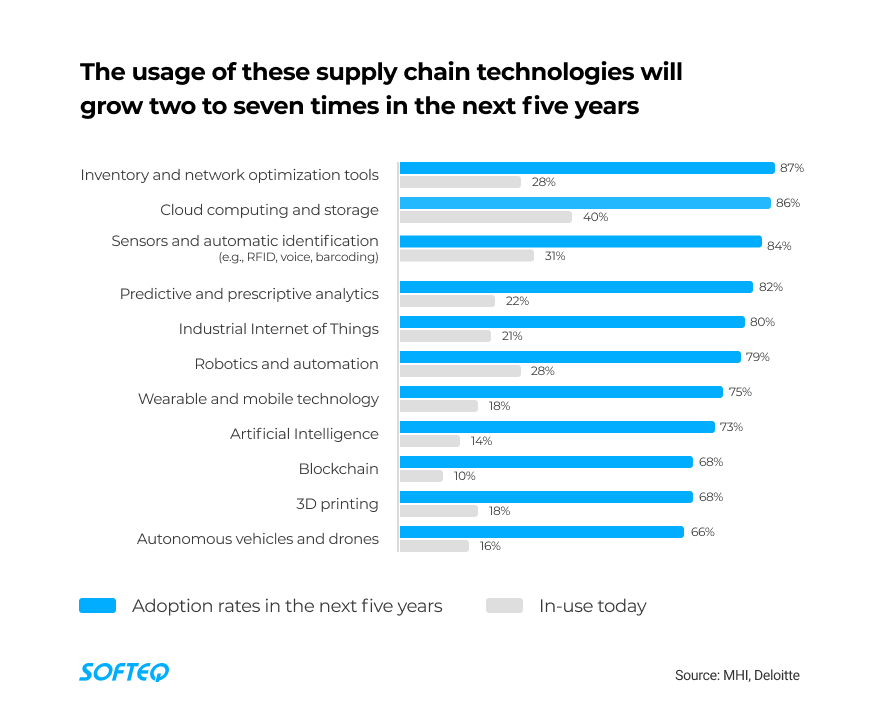
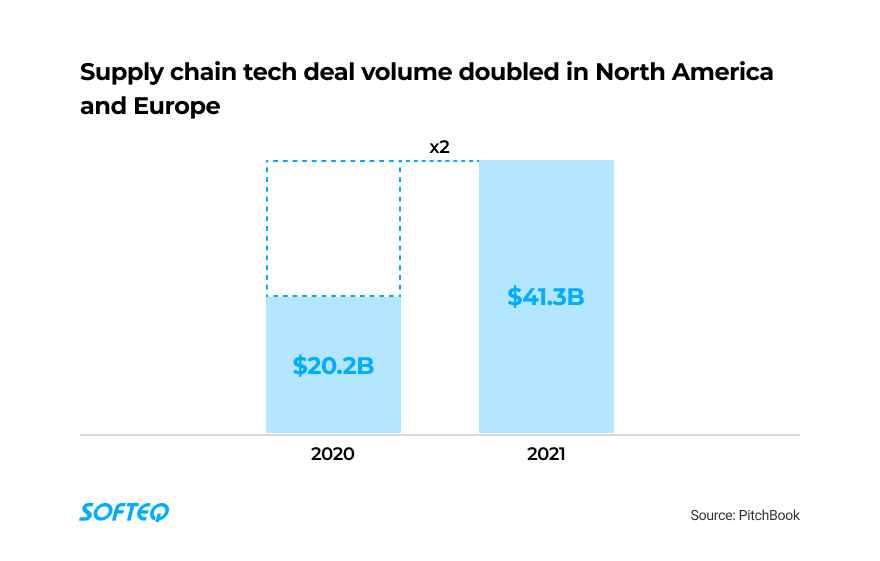
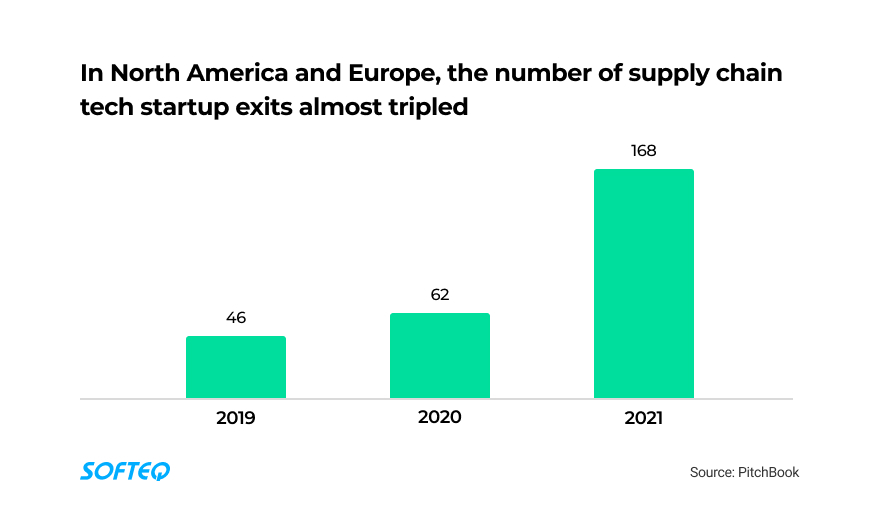
Now, let’s take a look at how supply chain innovations can help businesses survive in an era of global upheaval.
Case 1. Ensured Supplies: Building Resilient Supply Chains with Digital Twins
For decades, businesses focused on minimizing costs and reducing inventory. Interruptions in production were rare, so supply chain resilience took a back seat. As a result, the crisis of the last two years took many by surprise.
Now companies have to reshape their supply chains. To do this, they need to analyze different options and calculate how their business would be impacted. This is where smart supply chain IoT technologies like digital twins are a great help.
Digital twins are virtual models of real-world objects and processes. They can simulate the chaos of global supply chains, like problems with vendors and transportation. The technology can also predict the impact of a disruptive event on the supply chain and suggest actions to minimize harm.
Real-life Example: Simulating Changes in the Supply Network with Digital Twins
The German startup, Logivations, has developed an AI solution that creates a digital twin of a supply chain. It can visualize product flows, transport volumes, and costs at every level of a supply chain. The solution collects data from different systems, corrects data inconsistencies, and creates a digital model.
The software can also create what-if scenarios based on an interactive map. The model created shows how outside events or changes in the supply chain network may affect the entire supply chain.
Benefits at a Glance
- Better preparation for upcoming shortages by modeling them
- Reduced costs by optimizing the supply chain network
Case 2. Retail Logistics: Optimizing Inventory
Retailers always run the risk of being out of stock on popular items and overstocked on the products that sell less. In this case, a retailer will constantly lose out on sales of a popular item, tying up revenue in unsold inventory. Today’s risks make it even more difficult to choose whether to save money on expensive storage or purchase and store more stock.
Operational tasks like these take up to 80% of retailers’ time. They have to track inventory, calculate ideal stock levels, and replenish inventory in advance. They also need to consider external risks, which have become more frequent over the past few years. This may be a daunting task for humans, but smart supply chain solutions with AI are perfectly capable.
Real-Life Example: Finding the Perfect Replenishing Strategy
The US startup, Flieber, developed a platform for e-commerce retailers. It uses advanced data analytics and machine learning to predict sales and determine an ideal inventory level. The system also tells retailers when to replenish so that new inventory arrives before they become out of stock.
For example, the system determines how certain items are sold. Then, it alerts the retailer, telling them to place an order for new inventory by a certain date so that they can sell it several months from that date. If a retailer launches a new product, the system can predict how well it will sell.
As a result, companies can reduce excess inventory (which hurts sales) and stock enough strategic products on time.
Benefits at a Glance
- Optimized replenishment
- More time for retailers to focus on core tasks instead of operational tasks
Case 3. Freight Trucking: Dealing with Soaring Diesel Prices
Three out of four trucks on the road in the US are powered by diesel fuel. In March 2022, the retail price for diesel hit an all-time high of $5.11 per gallon. Compared to the year before, the price had doubled.
For independent operators and small fleets, this was a serious blow as they have less leverage over shippers. Their customers are in no hurry to agree to price increases which reflect the rise in the price of diesel. This is forcing truckers to save on vehicle repairs and other costs.
Smart routing solutions can help trucks reduce costs and fuel consumption. They use AI algorithms to analyze data like local traffic, weather, and gate codes. Then, the solutions propose the route with minimal mileage and time on the road.
Real-Life Example: Routing Optimization
The US company, Wise System, created an AI-driven routing platform to solve the core problem of each routing strategy. This is the so-called traveling salesman problem, or TSP. Its main idea is to find the most profitable route through different cities. Doing this manually can be mind-boggling. For example, if you need to create a route for ten stops, you’ll get more than 3.6M combinations.
The software uses AI algorithms to calculate the optimal route. The system can adapt the route during the delivery day based on new orders and changes in the situation on the road.
Benefits at a Glance
- Reduced delivery distance by 15%
- Increased delivery punctuality by 80%
- Reduced fleet downtime by 20%
Case 4. Cybersecurity: Protecting Weak Links in Digitized Supply Chains
Larger companies usually have a strong security system. That’s why hackers often try to gain access to confidential data through their smaller suppliers. This accounts for 40% of all cyber attacks.
One of the most famous cases occurred in 2013 with Target. Hackers managed to penetrate their system by compromising the credentials of one of their suppliers. This led to the theft of 70 million customers’ personal information, the CEO’s resignation, and over $200 million in costs.
Such cases demonstrate that businesses need to protect their assets, even if they’re outside the traditional attack zone. But traditional systems can only monitor assets that directly interface the enterprise IT infrastructure.
Real-Life Example: Analyzing Outside-Facing Connections
The Israeli startup, Cyberpion, developed a third-party risk management system. Unlike traditional solutions, the system focuses on all the connected IT assets. The software monitors all the assets to the nth degree and assesses their security.
Benefits at a Glance
- Avoided costs caused by data leakage
- Prevented reputational risks
- Avoided fines
Case 5. Port-to-Port Shipping: Dealing with Ocean Freight Risks
In addition to fuel prices, the freight industry is facing another big problem. We’re talking about a container shortage.
It all started back when the WHO declared the COVID-19 pandemic and manufacturers closed their factories. Transcontinental containers got stuck in ports in North America, because US manufacturers couldn’t produce enough goods for export. In response to falling demand, shippers also reduced the number of vessels at sea.
Manufacturing recovered faster in other countries than in North America, which led to a container shortage. Container bookings are hard to find at the moment as a result, and prices have increased by up to 20 times. And since the container manufacturing industry is not expected to grow significantly in the next few years, it means the shortage will not be solved anytime soon.
Supply chain innovations will not be able to increase the amount of containers, of course. But technology can make ocean shipping more efficient. There is huge space for improvement here, since freight forwarders still manage their operations manually. They track shipments with a call or online lookup, and then enter that data into an Excel spreadsheet.
Real-Life Example: Predicting Ocean Freight Issues
The Singapore startup, Portcast, developed a platform for ocean shipping. It tracks ships in real time and creates shorter routes between ports.
Using AI, Portcast analyzes data such as ship position, speed, direction, ports, wind speed, and wave height. They also look at economic patterns, weather, and issues like the Suez Canal blockage. Additionally, Portcast tracks more than 90% of the global ocean carrier trade and 35% of air cargo.
All this makes the system capable of predicting outages, their cause, and resulting delays. This means shippers can now better prepare their trucking and warehousing teams for container arrivals.
Benefits at a Glance
- Faster delivery by identifying the shortest route
- Better response to cargo delays through real-time visibility and AI predictions
Wrapping Up
Innovation in supply chain management helps companies monitor the situation, predict outages, and find workarounds. Retail shops can be sure strategic stockpiles are always in stock. Freight companies can cut their fuel consumption to react to rising fuel costs. Smart solutions can also protect sensitive data, even if hackers decide to act through the weakest link in the supply chain.
If you want to develop a similar solution to ensure a flexible and resilient supply chain, Softeq can help you out. With us, you’ll have a team of hardware, embedded systems, and software experts all under one roof. Contact us to learn more.
More articles on the topic




